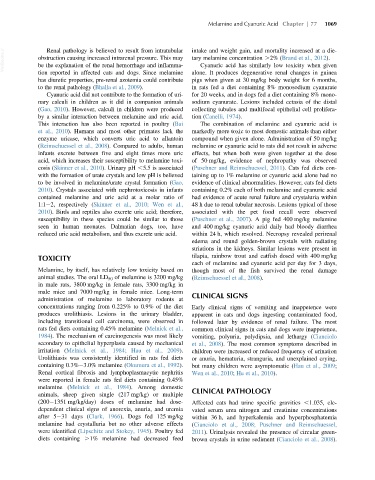Page 1137 - Veterinary Toxicology, Basic and Clinical Principles, 3rd Edition
P. 1137
Melamine and Cyanuric Acid Chapter | 77 1069
VetBooks.ir obstruction causing increased intrarenal pressure. This may intake and weight gain, and mortality increased at a die-
Renal pathology is believed to result from intratubular
tary melamine concentration .2% (Brand et al., 2012).
be the explanation of the renal hemorrhage and inflamma-
Cyanuric acid has similarly low toxicity when given
tion reported in affected cats and dogs. Since melamine alone. It produces degenerative renal changes in guinea
has diuretic properties, pre-renal azotemia could contribute pigs when given at 30 mg/kg body weight for 6 months,
to the renal pathology (Bhalla et al., 2009). in rats fed a diet containing 8% monosodium cyanurate
Cyanuric acid did not contribute to the formation of uri- for 20 weeks, and in dogs fed a diet containing 8% mono-
nary calculi in children as it did in companion animals sodium cyanurate. Lesions included ectasia of the distal
(Gao, 2010). However, calculi in children were produced collecting tubules and multifocal epithelial cell prolifera-
by a similar interaction between melamine and uric acid. tion (Canelli, 1974).
This interaction has also been reported in poultry (Bai The combination of melamine and cyanuric acid is
et al., 2010). Humans and most other primates lack the markedly more toxic to most domestic animals than either
enzyme uricase, which converts uric acid to allantoin compound when given alone. Administration of 50 mg/kg
(Reimschuesseletal., 2008). Compared to adults, human melamine or cyanuric acid to rats did not result in adverse
infants excrete between five and eight times more uric effects, but when both were given together at the dose
acid, which increases their susceptibility to melamine toxi- of 50 mg/kg, evidence of nephropathy was observed
cosis (Skinner et al., 2010). Urinary pH ,5.5 is associated (Puschner and Reimschuessel, 2011). Cats fed diets con-
with the formation of urate crystals and low pH is believed taining up to 1% melamine or cyanuric acid alone had no
to be involved in melamine/urate crystal formation (Gao, evidence of clinical abnormalities. However, cats fed diets
2010). Crystals associated with nephrotoxicosis in infants containing 0.2% each of both melamine and cyanuric acid
contained melamine and uric acid at a molar ratio of had evidence of acute renal failure and crystaluria within
1:1 2, respectively (Skinner et al., 2010; Wen et al., 48 h due to renal tubular necrosis. Lesions typical of those
2010). Birds and reptiles also excrete uric acid; therefore, associated with the pet food recall were observed
susceptibility in these species could be similar to those (Puschner et al., 2007). A pig fed 400 mg/kg melamine
seen in human neonates. Dalmatian dogs, too, have and 400 mg/kg cyanuric acid daily had bloody diarrhea
reduced uric acid metabolism, and thus excrete uric acid. within 24 h, which resolved. Necropsy revealed perirenal
edema and round golden-brown crystals with radiating
striations in the kidneys. Similar lesions were present in
TOXICITY tilapia, rainbow trout and catfish dosed with 400 mg/kg
each of melamine and cyanuric acid per day for 3 days,
Melamine, by itself, has relatively low toxicity based on though most of the fish survived the renal damage
animal studies. The oral LD 50 of melamine is 3200 mg/kg (Reimschuessel et al., 2008).
in male rats, 3800 mg/kg in female rats, 3300 mg/kg in
male mice and 7000 mg/kg in female mice. Long-term CLINICAL SIGNS
administration of melamine to laboratory rodents at
concentrations ranging from 0.225% to 0.9% of the diet Early clinical signs of vomiting and inappetence were
produces urolithiasis. Lesions in the urinary bladder, apparent in cats and dogs ingesting contaminated food,
including transitional cell carcinoma, were observed in followed later by evidence of renal failure. The most
rats fed diets containing 0.45% melamine (Melnick et al., common clinical signs in cats and dogs were inappetence,
1984). The mechanism of carcinogenesis was most likely vomiting, polyuria, polydipsia, and lethargy (Cianciolo
secondary to epithelial hyperplasia caused by mechanical et al., 2008). The most common symptoms described in
irritation (Melnick et al., 1984; Hau et al., 2009). children were increased or reduced frequency of urination
Urolithiasis was consistently identified in rats fed diets or anuria, hematuria, stranguria, and unexplained crying,
containing 0.3% 3.0% melamine (Okumura et al., 1992). but many children were asymptomatic (Hau et al., 2009;
Renal cortical fibrosis and lymphoplasmacytic nephritis Wen et al., 2010; Hu et al., 2010).
were reported in female rats fed diets containing 0.45%
melamine (Melnick et al., 1984). Among domestic CLINICAL PATHOLOGY
animals, sheep given single (217 mg/kg) or multiple
(200 1351 mg/kg/day) doses of melamine had dose- Affected cats had urine specific gravities ,1.035, ele-
dependent clinical signs of anorexia, anuria, and uremia vated serum urea nitrogen and creatinine concentrations
after 5 31 days (Clark, 1966). Dogs fed 125 mg/kg within 36 h, and hyperkalemia and hyperphosphatemia
melamine had crystalluria but no other adverse effects (Cianciolo et al., 2008; Puschner and Reimschuessel,
were identified (Lipschitz and Stokey, 1945). Poultry fed 2011). Urinalysis revealed the presence of circular green-
diets containing .1% melamine had decreased feed brown crystals in urine sediment (Cianciolo et al., 2008).

